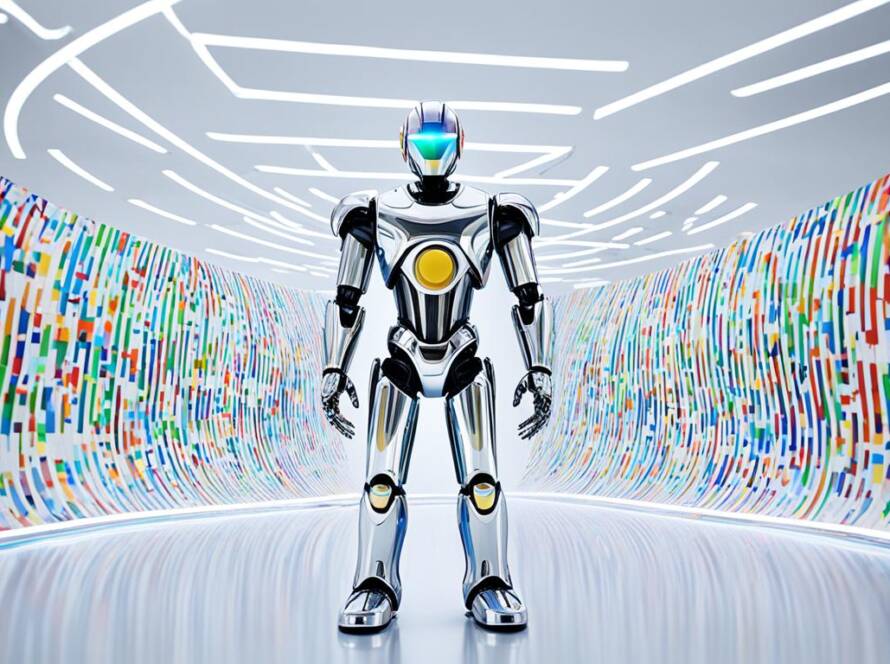The world of artificial intelligence (AI) is growing fast, with its market value expected to hit $126 billion by 2025. What makes it confusing is the mix of terms and how everything is connected. For example, machine learning (ML) and deep learning (DL) are parts of AI. But what is AI exactly? AI is the field where we make machines do smart things. Understanding AI is crucial as it encompasses these various technologies and methods that enable machines to mimic human intelligence and perform tasks that typically require human cognition.
ML is a big part of AI. It lets machines learn from big piles of data. This learning happens on its own, making the machines more accurate without us telling them step by step.
AI’s big breakthrough came with neural networks. These are like our brains’ way of processing information. Thanks to this technology, computers can now spot patterns and guess the future based on data. Webaie, for example, shows how AI can improve our experiences online by doing smart things when we interact with websites. This combines the power of AI with making the web better for us.
Neural networks are key for AI to work like we do. They help with recognising patterns and making predictions. From predicting if a customer will like a new product to understanding what a message really means, AI is helping businesses in many ways. Machines are getting better at many jobs, from simple tasks to helping with important decisions.
Key Takeaways
- The AI market is expected to reach $126 billion by 2025.
- AI helps businesses automate administrative tasks and supports complex decision-making.
- Neural networks, inspired by human cognition, are crucial for pattern recognition and predictions1.
- Web AI Engines like Webaie enhance web experiences through advanced AI capabilities.
- Machine learning algorithms improve accuracy by autonomously learning from data1.
Introduction to AI and Machine Learning
Artificial intelligence (AI) mimics human thinking. It allows computer systems to carry out smart tasks, like learning and deciding. These systems help us work better by doing complex jobs.
Defining Artificial Intelligence
AI includes speech recognition, understanding words we speak, and making sense of written or spoken language2. It also involves recognising faces, objects, and actions within images and videos, which makes visual search possible2. Businesses use AI to predict future trends and behaviours by analysing vast data sets2. This predictive power is key for making better decisions2.
Understanding Machine Learning
Machine learning (ML) is a vital part of AI. It uses data without being told directly what to do2. As it processes more data, ML gets better at providing accurate insights and suggestions. Neural networks, modelled after the human brain, help in deep learning for more advanced AI2.
Combine ML and AI with robotic process automation, and you get enhanced efficiency. This duo cuts costs and frees up resources for other tasks2. For instance, in manufacturing, it enables predictive maintenance. In customer service, it makes chatbots smarter2. In healthcare and finance, it improves service with better diagnostics and risk analysis3. It’s changing the game in many fields.
| Industry | Application | Benefit |
|---|---|---|
| Healthcare | Image Processing | Improved Cancer Detection2 |
| Retail | Inventory Optimisation | Enhanced Customer Experience2 |
| Finance | Fraud Detection | Proactive Financial Advice2 |
AI Engines and Their Applications
AI Engines are changing many areas by using algorithms that work like the brain. These algorithms help computers understand and use big sets of data. This data helps make smart decisions. The way AI Engines work is based on how our brains learn.
Neural Network Algorithms
Neural network algorithms form the heart of AI Engines. They help make sense of different kinds of data fast. Google Brain’s open-source tool, TensorFlow, is key for many big companies. They use it to create smart systems. For example, it helps Amazon’s chatbot understand what people say4. Using these tools, smart systems can do amazing things. They can learn from data just like we do.
Applications in Various Industries
AI is essential in many fields. In shops, it manages stock and suggests items tailored to each person. Amazon is a great example of this tech in action4. In medicine, AI supports doctors by making diagnoses more precise, leading to better outcomes for patients5. The financial world uses AI for safer banking, spotting fraud early, and to serve customers better5.
Tesla uses AI to make driving safer, with its smart features keeping cars on the road4. In health, AI not only looks at images but also can predict some medical problems5. It’s making patient care better.
AI is key in industry to predict when machines need care. This cuts down on breaks and keeps things running smooth. In safety roles, AI watches for unusual activities to keep places secure5.
For finance, AI spots fraud and manages risks to keep money safe. Its quick calculations are crucial for fast financial moves6. Companies use AI to stand out and stay ahead in their fields.
Conclusion
The world of AI and machine learning is always changing. It now brings us new AI tools that help in many areas.
AI can work with not just text but also pictures and videos. This makes websites more interactive and fun7. We’ll notice big changes in areas like design and fashion because of this. It’s a mix of human creativity and AI’s powerful maths. Together, they’re making something really cool.
Soon, quantum computing will make AI even smarter. It will help in finding new medicines, making messages secret, and solving big puzzles7. But, it’s important to be careful. People are working hard to make sure AI is fair and honest. These efforts will keep AI good for everyone.
AI is becoming a big part of our lives thanks to smart tools like the Web AI Engine7. They make websites better and help in many jobs. These tools show how important AI is for making new things and helping us move forward in technology.
Source Links
- https://www.infoworld.com/article/3702651/the-engines-of-ai-machine-learning-algorithms-explained.html
- https://azure.microsoft.com/en-gb/resources/cloud-computing-dictionary/artificial-intelligence-vs-machine-learning
- https://www.england.nhs.uk/long-read/artificial-intelligence-ai-and-machine-learning/
- https://www.agicent.com/blog/best-ai-engines/
- https://www.lenovo.com/us/en/glossary/ai-engine/
- https://www.14core.com/wp-content/uploads/2022/12/wp506-ai-engine-AI-Engines-and-Their-Applications.pdf
- https://www.linkedin.com/pulse/exploring-future-ai-engines-trends-predictions-ryan-perera-y9bke



